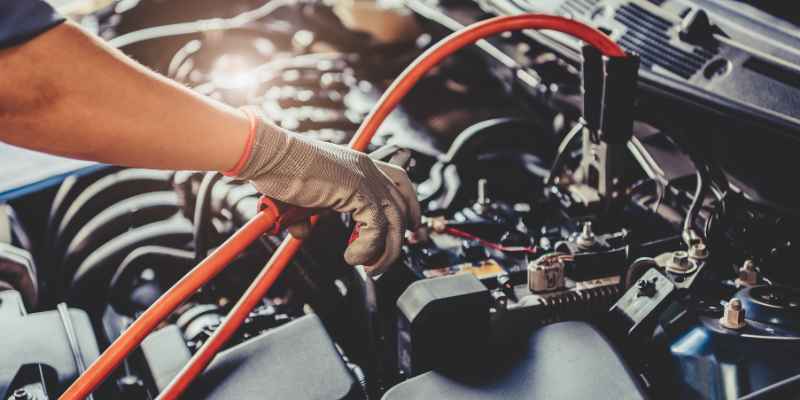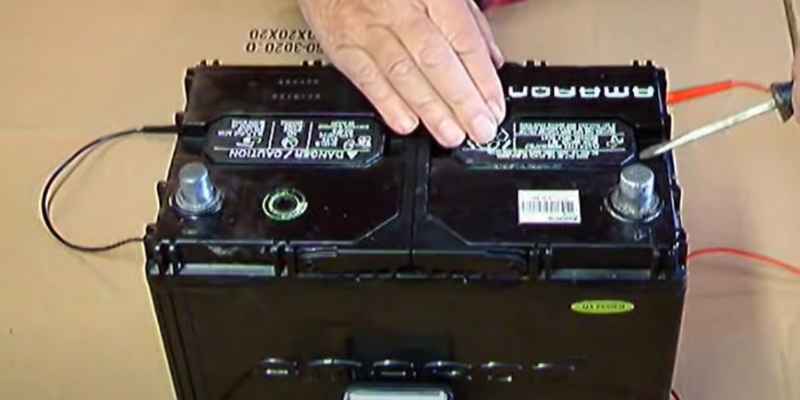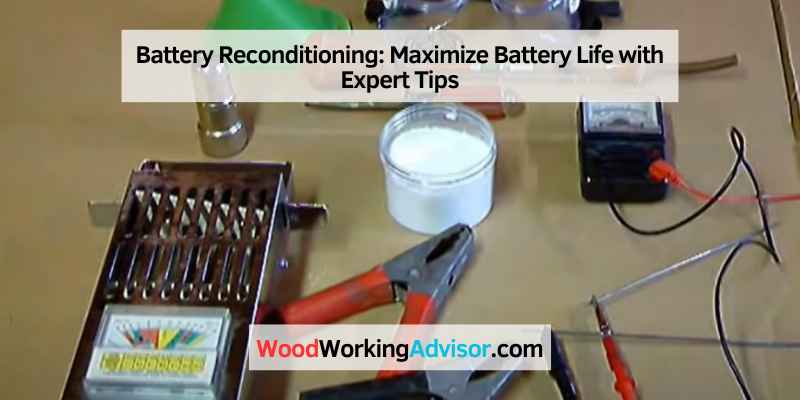Battery reconditioning is the process of restoring the performance and lifespan of old or dead batteries. By eliminating sulfation, a common cause of battery failure, and restoring the electrolyte balance, reconditioning can extend the battery’s usability.
This process can be done using different methods, such as desulfation chargers, chemical additives, or manual techniques. Battery reconditioning is gaining popularity as a cost-effective and eco-friendly solution, as it allows users to revive old batteries instead of buying new ones.
Moreover, it can be applied to various types of batteries, including lead-acid, lithium-ion, nickel-cadmium, and more. By understanding the fundamentals of battery reconditioning, individuals can save money, reduce waste, and extend the lifespan of their batteries.
The Basics Of Battery Reconditioning
Learn the fundamentals of battery reconditioning. Extend the lifespan of your old batteries by reviving them with simple techniques like cleaning, recharging, and restoring. Save money and reduce environmental impact with this sustainable practice.
Battery reconditioning is a cost-effective and environmentally friendly way to extend the lifespan of old batteries by restoring their performance. By following simple steps, you can revitalize batteries, saving money and reducing waste. Let’s dive into the fundamental concepts behind battery reconditioning.
What Is Battery Reconditioning?
Battery reconditioning involves the process of restoring the capacity and performance of old or worn-out batteries. By eliminating sulfation buildup and rejuvenating the cells, reconditioning can bring new life to batteries that would typically be discarded. This method is commonly used for lead-acid batteries found in cars, laptops, and other electronic devices.
Why Is Battery Reconditioning Important?
– Cost-Effective: Reconditioning batteries costs a fraction of buying new ones.
– Environmentally Friendly: Reducing the number of batteries disposed of in landfills helps the environment.
– Sustainable Practice: Extending the lifespan of batteries conserves resources and reduces the need for new raw materials.
– Convenience: Reconditioning batteries at home is a simple process that anyone can learn.
By understanding the basics of battery reconditioning, you can save money, reduce waste, and contribute to a more sustainable future. Start reconditioning your batteries today!

Signs Your Battery Needs Reconditioning
The key to prolonging the life of your battery lies in recognizing the signs that it needs reconditioning. By catching these signs early on, you can take the necessary steps to revive your battery’s performance and save yourself the hassle and cost of purchasing a new one. In this section, we’ll explore the common signs that indicate your battery is due for reconditioning.
Decreased Performance
If you have noticed a significant decrease in the performance of your battery, it could be a clear indicator that reconditioning is required. Over time, batteries can become less efficient and struggle to hold a charge. This results in reduced power output and longer charging times. You may find that your devices or vehicles have become sluggish or are unable to function optimally due to the weakened battery’s performance. Reconditioning helps restore the lost capacity, allowing your battery to perform at its full potential once again.
Frequent Recharging
Are you finding yourself having to recharge your battery more frequently than before? The need for more frequent recharging is a strong sign that your battery is in need of reconditioning. As batteries age, they lose their ability to hold a charge for extended periods. This leads to the need for more frequent recharges to keep your devices powered or your vehicle running. By reconditioning your battery, you can regain its ability to hold a charge for longer, reducing the need for constant recharging and improving overall efficiency.
Tools And Materials Needed
Battery reconditioning is a cost-effective and environmentally friendly way to extend the life of old or depleted batteries. To start reconditioning batteries, you will need specific tools and materials. Let’s take a look at the essential tools and safety equipment required for battery reconditioning.
Essential Tools For Battery Reconditioning
When reconditioning batteries, several essential tools are necessary to carry out the process effectively. These tools include a digital multimeter, battery charger, hydrometer, battery load tester, and a desulfation charger. These tools are crucial for testing and charging batteries, as well as for identifying battery issues.
Safety Equipment
Safety should always be a priority when reconditioning batteries, and the use of appropriate safety equipment is essential. Safety goggles, gloves, and a well-ventilated work area are crucial to protect against corrosive battery acids and other potential hazards. Using safety equipment can help prevent accidents and ensure a safer working environment.
Step-by-step Guide To Reconditioning
Battery reconditioning can be a cost-effective way to extend the life of your batteries. By following a step-by-step guide to reconditioning, you can breathe new life into old batteries and save money in the process. In this post, we will walk you through the preparation steps and reconditioning process, offering valuable insights into how you can revive your old batteries. Let’s get started!
Preparation Steps
Before diving into the reconditioning process, it’s essential to take the necessary preparation steps to ensure a smooth and safe procedure. Here’s a handy checklist to get you started:
- Gather the necessary tools and materials, including safety goggles, gloves, a battery reconditioning charger, distilled water, and Epsom salt.
- Prepare a well-ventilated workspace to carry out the reconditioning process, as it may involve some chemical smells and fumes.
- Inspect the battery for any physical damage or leaks, and ensure it is free from any external electrical connections.
- Read the manufacturer’s instructions and safety guidelines for your specific type of battery, as different batteries may require different reconditioning methods.
Reconditioning Process
Once you’ve completed the preparation steps, you can move on to the reconditioning process itself. Follow these step-by-step instructions to recondition your battery effectively:
- Start by cleaning the battery terminals using a mixture of baking soda and water to remove any corrosion or buildup.
- Prepare the Epsom salt solution by mixing it with distilled water, and carefully add it to the battery cells according to the recommended proportions.
- Connect the battery reconditioning charger to the battery and follow the specific charging and discharging cycles recommended for your type of battery.
- Monitor the battery closely during the reconditioning process, ensuring it does not overheat or exhibit any signs of danger.
- Once the reconditioning process is complete, reassemble the battery and conduct a voltage test to ensure it has been successfully revived.
Expert Tips For Maximizing Battery Life
In this section, we will share some expert tips and practices that can help you maximize the lifespan of your batteries. By following these tips, you can ensure that your batteries last longer and provide reliable power when you need it.
Proper Maintenance Practices
Proper maintenance is key to extending the life of your batteries. By implementing the following practices, you can keep your batteries in optimal condition:
- Regular Cleaning: Regularly clean the battery terminals and connectors using a soft cloth or brush. This helps prevent corrosion and ensures good electrical contact.
- Monitoring Temperature: Avoid exposing your batteries to extreme temperatures, as it can shorten their lifespan. Store them in a cool and dry place to maintain their performance.
- Avoid Deep Discharge: Try not to fully discharge your batteries before recharging them. Deep discharging can shorten their lifespan. Instead, recharge them when they reach around 20-30% of their capacity.
Optimizing Charging Cycles
Another crucial factor in maximizing battery life is optimizing the charging cycles. The following tips will help you optimize the charging process:
- Follow Manufacturer’s Guidelines: Always refer to the manufacturer’s guidelines for charging recommendations specific to your battery type. Different batteries may have different optimal charging methods.
- Avoid Overcharging: Avoid leaving your batteries connected to a charger for an extended period after they are fully charged. Overcharging can lead to overheating and reduce battery lifespan.
- Use the Right Charger: Ensure you are using the correct charger designed for your specific battery type. Using an incompatible charger can cause damage and shorten battery life.
By implementing these expert tips for battery maintenance and optimizing charging cycles, you can significantly extend the lifespan of your batteries. Remember that proper maintenance and charging practices are paramount in keeping your batteries in the best possible condition.
Common Myths About Battery Reconditioning
There are several common myths surrounding battery reconditioning that need to be debunked. Contrary to popular belief, reconditioning batteries does not damage or shorten their lifespan. In fact, it can prolong the battery’s overall performance and save you money in the long run.
Common myths about battery reconditioning often lead to confusion and misinformation in the industry. Let’s debunk these misconceptions to shed light on the truth behind battery reconditioning.
Myth 1: Reconditioning Damages Batteries
Reconditioning myths are prevalent, with one major fallacy being that the process causes harm. In reality, proper reconditioning techniques can extend a battery’s lifespan.
Myth 2: Only Professionals Can Recondition Batteries
Another common misconception is that reconditioning batteries requires professional expertise. However, with the right guidance, anyone can learn to recondition batteries effectively.
Benefits Of Battery Reconditioning
Battery reconditioning offers various advantages both from a financial and environmental perspective.
Cost Savings
Battery reconditioning saves you money by extending the lifespan of your batteries.
Environmental Impact
Reconditioning batteries reduces waste and helps in minimizing environmental impact.
– Battery reconditioning extends battery lifespan.
– Helps save costs by not buying new batteries.
– Reduces environmental impact by minimizing waste.
– Promotes sustainability by reusing resources.

Frequently Asked Questions Of Battery Reconditioning
What Is Battery Reconditioning?
Battery reconditioning is the process of reviving old, worn-out batteries to restore their performance and extend their lifespan. This involves removing sulfation and other build-ups, replenishing electrolytes, and balancing the cells to optimize battery function.
Can All Types Of Batteries Be Reconditioned?
Most common types of batteries, including lead-acid, lithium-ion, and nickel-cadmium, can be reconditioned to some extent. However, the success and effectiveness of reconditioning may vary based on the battery’s age, condition, and the specific reconditioning methods used.
Is Battery Reconditioning Safe?
When performed following proper guidelines and precautions, battery reconditioning can be safe. However, it involves working with potentially hazardous chemicals and electricity, so it’s essential to use protective gear and follow correct procedures to ensure personal safety and prevent accidents.
Does Battery Reconditioning Save Money?
Yes, battery reconditioning can save significant money by extending the lifespan and performance of old batteries. It eliminates the need to frequently purchase new batteries, reducing environmental impact and overall expenditure on replacements, making it a cost-effective and eco-friendly solution.
Conclusion
To sum up, battery reconditioning is a cost-effective and environmentally friendly solution to rejuvenate old and weak batteries. By following simple steps and using readily available materials, you can extend the lifespan of your batteries, saving money and reducing waste.
So, don’t discard your batteries just yet – give reconditioning a try and enjoy longer-lasting power for your devices. Start reconditioning now and reap the benefits for years to come!


